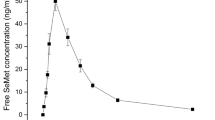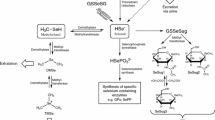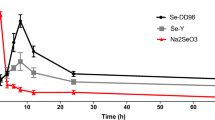Abstract
A human in vivo metabolism study was carried out to investigate the impact of the trimethylselenium ion (TMSe) status on metabolism and toxicokinetics of sodium selenite and selenized yeast. Nine healthy human volunteers were orally exposed to 200 µg selenium as sodium selenite and seven with selenized yeast (100 µg selenium). In each intervention group, three subjects belong to TMSe eliminators. Blood samples were withdrawn before and up to 6 h after administration. Urine samples were collected before and within 24 h after administration. Total selenium (Se) was quantified in blood plasma and urine and low molecular Se species in urine. Selenium concentration in plasma increased from 84.5 ± 13.2 µg Se/L before to 97.4 ± 13.2 µg Se/L 2–3 h after selenite supplementation and 89.5 ± 12.9 µg Se/L to 92.1 ± 13.9 µg Se/L after selenized yeast intake. The oral ingestion caused an additional Se elimination via urine of 16.9 ± 10.6 µg/24 h (TMSe elim.: 10.8 ± 6.9 µg/24 h; non-TMSe elim.: 20.0 ± 11.3 µg Se/24 h) after selenite exposure and 11.8 ± 4.1 µg/24 h (TMSe elim.: 10.8 ± 4.6 µg/24 h; non-TMSe elim.: 12.6 ± 4.2 µg Se/24 h) after selenized yeast exposure. Methyl-2-acetamido-2-deoxy-1-seleno-β-d-galactopyranoside (SeSug1) was the main metabolite in all urine samples, whereas TMSe was another main metabolite in TMSe eliminators’ urine. After selenite exposure, a small amount of the dose (0.5 ± 0.2 %) was oxidized to selenate and rapidly excreted via urine. With the exception of selenite exposure in TMSe eliminators, the comparison of total Se and the sum of quantified Se species revealed a high renal portion of unidentified species. The study indicated a different metabolism of inorganic and organic Se compounds in human, but also crucial differences of Se metabolism in TMSe eliminators and non-TMSe eliminators.





Similar content being viewed by others
References
Barceloux DG (1999) Selenium. J Toxicol Clin Toxicol 37:145–172
Behne D, Kyriakopoulos A, Scheid S, Gessner H (1991) Effects of chemical form and dosage on the incorporation of selenium into tissue proteins in rats. J Nutr 121:806–814
Bendahl L, Gammelgaard B (2004) Separation and identification of Se-methylselenogalactosamine—a new metabolite in basal human urine—by HPLC–ICP-MS and CE-nano-ESI-(MS)2. J Anal At Spectrom 19:950–957. doi:10.1039/b406589a
Birringer M, Pilawa S, Flohé L (2002) Trends in selenium biochemistry. Nat Prod Rep 19:693–718. doi:10.1039/b205802m
Bügel S, Larsen EH, Sloth JJ, Flytlie K, Overvad K, Sternberg LC, Moesgaard S (2008) Absorption, excretion, and retention of selenium from a high selenium yeast in men with a high intake of selenium. Food Nutr Res. doi:10.3402/fnr.v52i0.1642
Cohen HJ, Fridovich I (1971) Hepatic sulfite oxidase. The nature and function of the HEME prosthetic groups. J Biol Chem 246:367–373
Esaki N, Nakamura T, Tanaka H, Suzuki T, Morino Y, Soda K (1981) Enzymatic synthesis of selenocysteine in rat liver. Biochemistry 20:4492–4496
Esaki N, Nakamura T, Tanaka H, Soda K (1982) Selenocysteine lyase, a novel enzyme that specifically acts on selenocysteine. Mammalian distribution and purification and properties of pig liver enzyme. J Biol Chem 257:4386–4391
Fairweather-Tait SJ, Collings R, Hurst R (2010) Selenium bioavailability: current knowledge and future research requirements. Am J Clin Nutr 91:1484S–1491S
Fairweather-Tait SJ, Bao Y, Broadley MR, Collings R, Ford D, Hesketh JE, Hurst R (2011) Selenium in human health and disease. Antioxid Redox Signal 14:1337–1383
Francesconi KA, Pannier F (2004) Selenium metabolites in urine: a critical overview of past work and current status. Clin Chem 50:2240–2253. doi:10.1373/clinchem.2004.039875
Gammelgaard B, Bendahl L (2004) Selenium speciation in human urine samples by LC- and CE-ICP-MS—separation and identification of selenosugars. J Anal At Spectrom 19:135–142. doi:10.1039/b307539g
Gammelgaard B, Jessen KD, Kristensen FH, Jøns O (2000) Determination of trimethylselenonium ion in urine by ion chromatography and inductively coupled plasma mass spectrometry detection. Anal Chim Acta 404:47–54. doi:10.1016/s0003-2670(99)00692-3
Gammelgaard B, Madsen KG, Bjerrum J, Bendahl L, Jøns O, Olsen J, Sidenius U (2003) Separation, purification and identification of the major selenium metabolite from human urine by multidimensional HPLC–ICP-MS and APCI-MS. J Anal At Spectrom 18:65–70. doi:10.1039/b209832f
Gammelgaard B, Bendahl L, Jacobsen NW, Stürup S (2005) Quantitative determination of selenium metabolites in human urine by LC-DRC–ICP-MS. J Anal At Spectrom 20:889–893. doi:10.1039/b504612b
Gammelgaard B, Stürup S, Christensen MV (2012) Human urinary excretion and metabolism of 82Se-enriched selenite and selenate determined by LC–ICP-MS. Metallomics 4:149–155. doi:10.1039/c2mt00163b
Göen T, Schaller KH, Drexler H (2012) External quality assessment of human biomonitoring in the range of environmental exposure levels. Int J Hyg Environ Health 215:229–232. doi:10.1016/j.ijheh.2011.08.012
Göen T, Schaller B, Jäger T, Bräu-Dümler C, Schaller KH, Drexler H (2015) Biological monitoring of exposure and effects in workers employed in a selenium-processing plant. Int Arch Occup Environ Health 88:623–630. doi:10.1007/s00420-014-0989-7
Griffiths NM, Stewart RDH, Robinson MF (1976) The metabolism of [75Se]selenomethionine in four women. Br J Nutr 35:373–382
Hornung RW, Reed LD (1990) Estimation of average concentration in the presence of nondetectable values. Appl Occup Environ Hyg 5:46–51
Hsieh HS, Ganther HE (1977) Biosynthesis of dimethyl selenide from sodium selenite in rat liver and kidney cell free systems. Biochim Biophys Acta 497:205–217
Jäger T, Drexler H, Göen T (2013) Ion pairing and ion exchange chromatography coupled to ICP-MS to determine selenium species in human urine. J Anal At Spectrom 28:1402–1409. doi:10.1039/c3ja50083g
Jäger T, Drexler H, Göen T (2015) Human metabolism and renal excretion of selenium compounds after oral ingestion of sodium selenate dependent on trimethylselenium ion (TMSe) status. Arch Toxicol. doi:10.1007/s00204-014-1380-x
Kremer D, Ilgen G, Feldmann J (2005) GC-ICP-MS determination of dimethylselenide in human breath after ingestion of 77Se-enriched selenite: monitoring of in vivo methylation of selenium. Anal Bioanal Chem 383:509–515
Kuehnelt D, Kienzl N, Traar P, Le NH, Francesconi KA, Ochi T (2005) Selenium metabolites in human urine after ingestion of selenite, L-selenomethionine, or DL-selenomethionine: a quantitative case study by HPLC/ICPMS. Anal Bioanal Chem 383:235–246. doi:10.1007/s00216-005-0007-8
Kuehnelt D, Juresa D, Kienzl N, Francesconi KA (2006) Marked individual variability in the levels of trimethylselenium ion in human urine determined by HPLC/ICPMS and HPLC/vapor generation/ICPMS. Anal Bioanal Chem 386:2207–2212. doi:10.1007/s00216-006-0848-9
Larsen EH, Hansen M, Paulin H, Moesgaard S, Reid M, Rayman M (2004) Speciation and bioavailability of selenium in yeast-based intervention agents used in cancer chemoprevention studies. J AOAC Int 87:225–232
Lu J, Berndt C, Holmgren A (2009) Metabolism of selenium compounds catalyzed by the mammalian selenoprotein thioredoxin reductase. BBA Gen Subj 1790:1513–1519
Lu Y, Rumpler A, Francesconi KA, Pergantis SA (2012) Quantitative selenium speciation in human urine by using liquid chromatography-electrospray tandem mass spectrometry. Anal Chim Acta 731:49–59. doi:10.1016/j.aca.2012.04.016
Marchante-Gayón JM, Feldmann I, Thomas C, Jakubowski N (2001) Speciation of selenium in human urine by HPLC–ICP-MS with a collision and reaction cell. J Anal At Spectrom 16:457–463. doi:10.1039/b008649p
Markovich D (2014) Na+-sulfate cotransporter SLC13A1. Pflug Arch Eur J Physiol 466:131–137
McConnell KP, Cho GJ (1965) Transmucosal movement of selenium. Am J Physiol 208:1191–1195
Navarro- Alarcón M, Cabrera-Vique C (2008) Selenium in food and the human body: a review. Sci Total Environ 400:115–141. doi:10.1016/j.scitotenv.2008.06.024
Nickel A, Kottra G, Schmidt G, Danier J, Hofmann T, Daniel H (2009) Characteristics of transport of selenoamino acids by epithelial amino acid transporters. Chem Biol Interact 177:234–241. doi:10.1016/j.cbi.2008.09.008
Rayman MP (2000) The importance of selenium to human health. Lancet 356:233–241
Rayman MP (2012) Selenium and human health. Lancet 379:1256–1268. doi:10.1016/s0140-6736(11)61452-9
Suzuki KT (2005) Metabolomics of selenium: Se metabolites based on speciation studies. J Health Sci 51:107–114. doi:10.1248/jhs.51.107
Suzuki KT, Doi C, Suzuki N (2006) Metabolism of 76Se-methylselenocysteine compared with that of 77Se-selenomethionine and 82Se-selenite. Toxicol Appl Pharmacol 217:185–195
Swanson CA et al (1991) Human [74Se]selenomethionine metabolism: a kinetic model. Am J Clin Nutr 54:917–926
Thomson CD, Robinson MF (1986) Urinary and fecal excretions and absorption of a large supplement of selenium: superiority of selenate over selenite. Am J Clin Nutr 44:659–663
Van Dael P, Davidsson L, Muñoz-Box R, Fay LB, Barclay D (2001) Selenium absorption and retention from a selenite- or selenate-fortified milk-based formula in men measured by a stable-isotope technique. Br J Nutr 85:157–163
Van Dael P, Davidsson L, Ziegler EE, Fay LB, Barclay D (2002) Comparison of selenite and selenate apparent absorption and retention in infants using stable isotope methodology. Pediatr Res 51:71–75
Wolffram S, Ardüser F, Scharrer E (1985) In vivo intestinal absorption of selenate and selenite by rats. J Nutr 115:454–459
Acknowledgments
The authors are grateful to the volunteers for taking part in the oral exposure study.
Conflict of interest
The authors declare no conflict of interest.
Author information
Authors and Affiliations
Corresponding author
Rights and permissions
About this article
Cite this article
Jäger, T., Drexler, H. & Göen, T. Human metabolism and renal excretion of selenium compounds after oral ingestion of sodium selenite and selenized yeast dependent on the trimethylselenium ion (TMSe) status. Arch Toxicol 90, 1069–1080 (2016). https://doi.org/10.1007/s00204-015-1548-z
Received:
Accepted:
Published:
Issue Date:
DOI: https://doi.org/10.1007/s00204-015-1548-z




